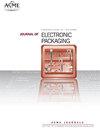Assessing the SAC305 Solder Joint Fatigue in BGA Assembly Using Strain-Controlled and Stress-Controlled Approaches
IF 2.3
4区 工程技术
Q3 ENGINEERING, ELECTRICAL & ELECTRONIC
引用次数: 5
Abstract
One of the crucial factors in determining the reliability of an electronic device is fatigue failure of the interconnecting solder joints. In most cases, large bulk samples are used to study the fatigue characteristics of the solder materials. Real solder joints often encountered in ball grid array (BGA) components have only been considered in limited investigations. In this study, a specialized sandwich BGA test vehicle with a 3×3 solder joint was connected to the two substrates. The alloys were tested at room temperature using an Instron micromechanical tester in both the stress-controlled and strain-controlled methods. The tests were performed at a constant strain rate. Four stresses and four strain levels of the solder alloy Sn-3.0Ag-0.5Cu (SAC305) were examined using organic solderability preservative (OSP) and electroless nickel-immersion silver (ENIG) surface finishes. The work per cycle and plastic strain range were computed based on a systematic recording of the stress-strain (hysteresis) loops of each sample. A novel approach based on inelastic work is developed to calculate the fatigue life of a BGA assembled test vehicle. The results of the stress-controlled and strain-controlled tests indicated that the OSP surface finish outperformed the ENIG surface finish. Regardless of the testing process and surface finish, the Coffin-Manson and Morrow energy models were acceptable for SAC305.用应变控制和应力控制方法评估BGA装配中SAC305焊点的疲劳
决定电子器件可靠性的关键因素之一是互连焊点的疲劳失效。在大多数情况下,大体积样品用于研究焊料材料的疲劳特性。球栅阵列(BGA)元件中经常遇到的真实焊点仅在有限的研究中被考虑。在本研究中,将一个带有3×3焊点的专用夹层BGA测试车连接到两个基板上。合金在室温下使用Instron微机械测试仪以应力控制和应变控制两种方法进行测试。试验是在恒定的应变速率下进行的。采用有机可焊性防腐剂(OSP)和化学镀镍-浸银(ENIG)表面处理,对Sn-3.0Ag-0.5Cu(SAC305)焊料合金的四种应力和四种应变水平进行了检测。每个循环的功和塑性应变范围是基于对每个样品的应力-应变(磁滞)回路的系统记录来计算的。提出了一种基于非弹性功的BGA装配试验车疲劳寿命计算方法。应力控制和应变控制试验的结果表明,OSP表面光洁度优于ENIG表面光洁度。无论测试过程和表面光洁度如何,Coffin-Manson和Morrow能源模型都可用于SAC305。
本文章由计算机程序翻译,如有差异,请以英文原文为准。
求助全文
约1分钟内获得全文
求助全文
来源期刊

Journal of Electronic Packaging
工程技术-工程:电子与电气
CiteScore
4.90
自引率
6.20%
发文量
44
审稿时长
3 months
期刊介绍:
The Journal of Electronic Packaging publishes papers that use experimental and theoretical (analytical and computer-aided) methods, approaches, and techniques to address and solve various mechanical, materials, and reliability problems encountered in the analysis, design, manufacturing, testing, and operation of electronic and photonics components, devices, and systems.
Scope: Microsystems packaging; Systems integration; Flexible electronics; Materials with nano structures and in general small scale systems.
 求助内容:
求助内容: 应助结果提醒方式:
应助结果提醒方式:


